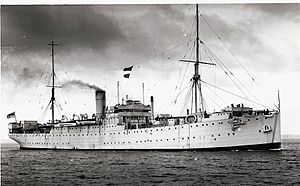HMS Cyclops (F31) facts for kids

HMS Cyclops off the Isle of Bute, circa 1943
|
|
Quick facts for kids History |
|
|---|---|
| Name | HMS Cyclops |
| Builder | Sir James Laing & Son, Sunderland |
| Launched | 27 October 1905 |
| Commissioned | 5 November 1907 |
| Nickname(s) | Cycle Box |
| Fate | Scrapped in 1947 |
| General characteristics | |
| Displacement | 11,300 long tons (11,500 t) |
| Length | 145.1 m (476 ft 1 in) o/a |
| Beam | 16.8 m (55 ft 1 in) |
| Draught | 2.51 m (8 ft 3 in) |
| Propulsion | Triple Expansion Engines = 1100 indicated horse power |
| Speed |
|
| Complement | 266 |
| Armament | Two 4 inch MkV naval guns |
HMS Cyclops (F31) was a special ship in the Royal Navy. It was known as a submarine repair and depot ship. This means it was like a floating workshop and home base for submarines.
Before it became a navy ship, Cyclops was going to be a passenger liner named Indrabarah. It was built by Sir James Laing & Son. But the British Navy, called The Admiralty, bought it while it was still being built. The ship was launched on October 27, 1905.
Cyclops was about 145.1 m (476 ft 1 in) long. It had a width, or beam, of about 16.8 m (55 ft 1 in).
Contents
A Ship's Busy Life: HMS Cyclops's Career
HMS Cyclops had a very active life, especially during both World Wars.
Serving in World War I
During the First World War, Cyclops worked as a repair ship. It was part of the Grand Fleet, which was the main fleet of the Royal Navy. Cyclops stayed at Scapa Flow, a naval base, for the entire war. It helped keep the other ships and submarines ready for action.
After the war, in 1919, the ship was sent to Archangel for duty in the White Sea. Later that year, it returned home.
Becoming a Submarine Home Base
In 1920, Cyclops was changed into a dedicated submarine depot ship. This meant it would be a floating base for submarines. It joined the 1st Submarine Flotilla in 1922.
World War II Duties
Between the two World Wars, Cyclops served in Malta. When the Second World War began, it was ready for action again.
In late 1939, it became the depot ship for the Royal Navy's 7th Submarine Flotilla. This group of submarines was based in Rothesay.
From November 1939 to May 1940, Cyclops supported the 3rd Submarine Flotilla. This group of submarines operated near Denmark. The crew gave Cyclops a fun nickname: "Cycle Box." In December 1939, the ship even used its 4-inch guns to fight off a German seaplane that was attacking the harbor.
Cyclops also took part in training exercises. For example, in May 1942, it was part of a group of ships used for practice attacks by submarines.
What Was Inside: Ship Facilities
HMS Cyclops was like a floating factory. It had many workshops to help repair other ships and submarines.
These included:
- A plant to make fresh water.
- Workshops for machinery, carpenters, and blacksmiths.
- Shops for working with copper.
- Foundries for casting iron and brass.
The End of its Journey
After many years of service, HMS Cyclops was sold in July 1947. It was taken to Newport and scrapped, which means it was taken apart for its materials.
See also
- Submarine depot ships
- HMS Ambrose (1903)
- HMS Hazard (1894)
- HMS Medway (1928)
- HMS Titania

